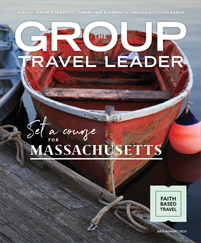Convention and visitors bureaus typically rely on a mix of public and private funding, memberships and various tax revenues to do what they do: market their destinations. But that means they have to show their stakeholders that the investment in travel and tourism is worth it.
Group leaders can help themselves and CVBs by communicating with the organizations. Doing so allows CVBs to be a resource to group leaders by letting them know about new products, stepping in to help with any bumps in the road and providing groups with little extras or special experiences.
Communication also helps the CVBs. If they can track motorcoaches coming to town, they can justify their investment in group sales efforts and strike a balance that works for groups coming to the city and the people who live there.
For more insight into the business of CVBs and the best ways for travel planners to work with them, we spoke with representatives of four destination marketing organizations around the country.
Visit Savannah
Last year, Visit Savannah tracked more than 14 million visitors, including nearly 3,000 motorcoaches, in the city’s historic district, a district that’s only 2.5 miles square.
With today’s stronger economy, more people are traveling than ever before, both domestically and internationally, and although that sounds like a good thing, many communities are faced with the notion of “overtourism,” said Joseph Marinelli, president of Visit Savannah. “In other words, when is too much too much?”
Tourism is positive from an economic development standpoint: visitor spending, increased jobs, new product development and more. But more visitors can also tax municipalities and their services, affecting public safety, traffic, crime and neighborhoods, he said.
One of Visit Savannah’s challenges is to make sure that everyone is having a good experience, not only visitors but also local businesses and residents, said Mindy Shea, director of tour, travel and international sales for Visit Savannah.
“We try very hard to keep that balance between tourism and livability in the city, and we’re tasked with being creative in how to do that and how to manage that,” she said. “There is no secret formula to doing that; we just have to manage it as it comes along.”
For example, Savannah provides buses with designated places to park, idle and offload and has rules about where and how motorcoaches can move around the historic district to avoid traffic backups. Visit Savannah helps relay that info by sharing links with maps and detailed information, and the city requires drivers to pick up permits in person to ensure they understand where they can and can’t go.
All of which ties in to how group leaders can work with CVBs. “Always remember that it’s a partnership,” Marinelli said.
Cities are incorporating new rules and guidelines to accommodate the larger numbers of visitors. Lodging partners are under more pressure than ever to manage their rates and revenues. Attractions and tours often struggle to find enough workforce to meet the demand.
“And the DMOs are the entities that are charged with bringing all the pieces together and making it work for everyone,” he said.
Group leaders can help CVBs do that through communication, Shea said.
“The biggest thing is to communicate with us while in the planning stages of building the tour and the itinerary,” she said. It’s important for the CVB to know what their group is looking for, their price range for hotels, how active the group is, whether they want free time and whether they prefer traditional tours and attractions or want more adventurous experiences.
“As much info as they can give us in those early planning stages, the better experience we can give them when they get here,” Shea said.
Visit Savannah uses traditional marketing methods such as print ads, radio and TV, as well as newer platforms such as digital, social media and video, Marinelli said. Industry trade shows are still extremely important, and the CVB will continue to do FAM trips “because we know operators need to see the destination to sell the destination,” Shea said.
Twenty years ago, there was concern that the group tour industry was disappearing, but today the industry knows that nothing could be further from the truth, Marinelli said, “so DMOs must continue to build marketing and advertising efforts to that segment into every aspect of their marketing plans.”











